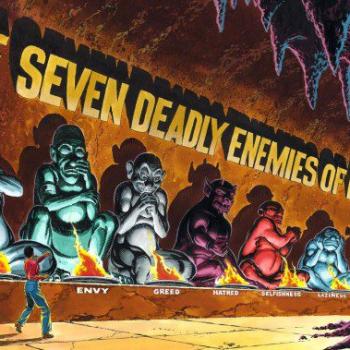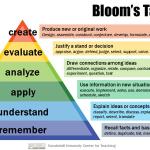So the other day I tripped over Tubal-cain and wound up wishing I’d paid more attention in my biblical studies classes and/or done more of the reading for my history classes.
Let me explain where this is going, then ask for your help in pointing me toward where I might learn more to sort this out.
The story of Tubal-cain is a bit obscure. It’s a one-liner tucked in amongst the “begats” of Genesis 4. The biblical begats — long genealogical lists — don’t make for compelling reading, and this section is even less compelling than most such lists, since it traces the children and grandchildren of Cain. It’s difficult to get too caught up in the details of these people since we know that they’re all about to drown in the flood a couple of pages later.
Like everything else in the book of Genesis — particularly in these first 11 chapters — this passage intends to tell us how and why everything got started. These chapters are overflowing with origin stories — just-so-stories of how the snake lost its legs, how the rose got its thorns, or of where rainbows or giants came from. Hidden here amongst the begats of Cain are three more mini origin stories, succinct little tales of the origins of nomadic herders, musicians and metalworkers.*
Those three things, we’re told, were innovations introduced by the firm of Lamech & Sons, a family that seems to have been the Bell Labs of prehistory:
Lamech took two wives; the name of one was Adah, and the name of the other Zillah. Adah bore Jabal; he was the ancestor of those who live in tents and have livestock. His brother’s name was Jubal; he was the ancestor of all those who play the lyre and pipe. Zillah bore Tubal-cain, who made all kinds of bronze and iron tools. The sister of Tubal-cain was Naamah.
What tripped me up here was Tubal-cain and the assertion there in Genesis 4:22 that he was the inventor of “all kinds of bronze and iron tools.”
One of the gaps between seminary grads and so-called “traditionalists” involves the question of who wrote the books of the Pentateuch and, more importantly, when they were written. The traditional folklore holds that Moses wrote the books of Moses — you know, just like Father Brown wrote the Father Brown mysteries. That’s not what most biblical scholars think. Those scholars — boo! hiss! liberal intellectuals! — believe these books were written much, much later.
And that brings us to what I don’t know here. The story of Tubal-cain certainly seems like it ought to be a part of this conversation about when the book of Genesis was written.
Here is a one-verse origin story about the invention of iron tools. It makes sense, then, to assume that this story was written some time after such tools were invented, which is to say this story could not have been written before the Iron Age.
We generally do not bother telling origin stories for things that haven’t yet originated. We couldn’t even if we wanted to. So attributing the story of Tubal-cain to an early Bronze Age author seems doubly anachronistic. In that framework, Genesis 4:22 might as well read, “Zillah bore Tubal-cain, who made iPhones and transparent aluminum.”
So here is my request. As Ta-Nehisi Coates often says to his readers, “Talk to me like I’m stupid.” I’m hoping some of you can point me in a good direction for clarifying two things:
1. Does anyone know of a good discussion of the authorship of Genesis that addresses this story of Tubal-cain? Or, more broadly, of a helpful book or article exploring metallurgy in the Bible and what it can suggest to us about the dating of these books? (I’m thinking also of things like Sisera’s iron chariots in the book of Judges.)
2. The “Iron Age” seems like an extremely flexible span of history, covering a very long period and a very different period for different cultures. Any attempt to pin down the historical context of the Moses story will locate it squarely in the Bronze Age, but the pertinent question here would be whether such a Moses figure could have known of “all kinds of iron tools.” For example, Ramesses II battled the Hittites, and they seem to have been precocious early adapters of iron tools. So if we posit an Egyptian prince circa 1200 BCE or circa 1446 BCE, would it make sense for such a man to speak of “all kinds of iron tools”?
– – – – – – – – – – – –
* This trio of mini-origin stories is pretty clearly out of place. They don’t work here where the authors/editors of Genesis have put them. The inventions of the sons of Lamech were all features of life for those reading and hearing the stories of the book of Genesis — which is to say they all remained features of life after the flood. The logic of the narrative of Genesis 1-11 does not allow us to accept Jabal as “the ancestor of those who live in tents and have livestock,” because that narrative does not allow Jabal to have any descendants at all. Oops.
My guess is that these references to Jabal and Jubal and Tubal-cain aren’t so much miniature stories here as they are allusions to other stories that the original authors/editors expected their audience to be familiar with and only needed to name-check here. I think it’s similar to if I wrote something like: “The Galveston seawall was the most ambitious public works project in southern Texas since Pecos Bill lassoed that tornado.” I’m not telling the story of Pecos Bill there, merely referring to it with the expectation that readers will know the full story. But again, that’s just my guess.
Oh, and if you don’t know the story of the Galveston seawall, then go read it now. It’s more audacious and astounding than any tall-tale involving Pecos Bill and it really happened.
















